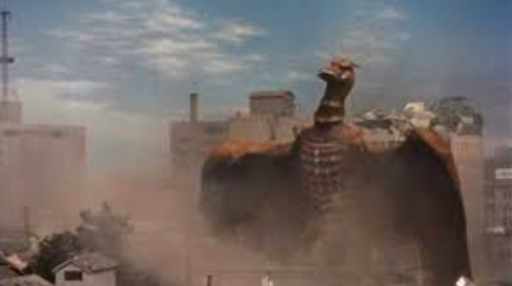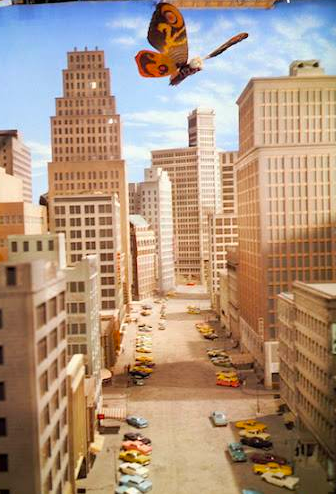Five Monsters Who Deserve The Minus One Treatment
Robert Dunakin ‘26 / Emtertainment Monthly Staff Writer
Godzilla fans have had cause to celebrate lately. Between the unprecedented box office run of last year’s Godzilla: Minus One and that film’s surprise Oscar win, the nearly seventy-year-old franchise has proven that it still has a lot of life left to live, and the potential to be taken in new directions. Godzilla: Minus One’s director, Takashi Yamazaki, has already spoken about a potential sequel, but it is the production company behind the film, Toho Studios, that has had the most to say about Godzilla’s future. Several years ago, Toho executive Kenji Ota revealed that the studio was exploring a “cinematic universe” for its characters. Save for Minus One, no new kaiju films have come from the studio since, and the studio has remained tight-lipped on the possibility of Minus One marking the beginning of such a universe. Toho is no stranger to the cinematic universe, with most of their science fiction output in the fifties, sixties, and seventies belonging to an interconnected world. Kaiju, like Mothra and Rodan, first debuted in their own films before taking on Godzilla. Film scholars have even pointed to kaiju crossovers like 1964’s Ghidorah the Three-Headed Monster as the blueprint for later films like The Avengers, with Ghidorah seeing Godzilla, Mothra, and Rodan join forces to battle the singular alien threat of Ghidorah.
Throughout Minus One, Yamazaki displays an immense reverence for the character and world of Godzilla, especially that seen in the original 1954 film. The film is able to not only evoke the mood of Ishiro Honda’s Godzilla but also enhance it, serving as an excellent companion piece to the original. Were the same standard held in a potential Toho cinematic universe, there are a myriad of films, characters, and kaiju in Toho’s back catalog who would be excellently suited to the Minus One treatment. A present-day reimagining could inject modern sensibility into these classics, without losing sight of the color, spectacle, and grandeur that has always made Toho’s sci-fi films so unique. With that said, here five Toho properties that would be best suited to such an update.

Rodan: Debuting solo in Toho’s first color monster film back in 1956 –the studio’s most immediate follow-up to the success of Godzilla– Rodan has endured as one of their most iconic monsters. Despite this pedigree, Rodan has only since appeared as a supporting character in Godzilla films, serving as a foil to the starring monster in films like Invasion of Astro-Monster and the aforementioned Ghidorah. Although made as a reaction to Godzilla’s success, Rodan does much to distinguish itself from its predecessor. Much of the film’s action takes place in the rural mining town of Kitamatsu, a welcomed departure from the urban or island settings employed in most of the fare to follow. Kitamatsu, and the blue-collar miners living there, give the audience a look into a different facet of Japanese life. This approach is well-suited for the character-driven drama of Minus One, with that film’s second act managing to engage audiences despite the almost total lack of monster action. Action-wise, Rodan has the potential for a totally different special effects sequences that could do for the air what Minus One did for the sea. A reimagining of Rodan could also bring back its secondary antagonists, the Meganulon: man-sized, prehistoric insects that could lend a different kind of horror into the proceedings.

Matango: Speak of different, 1963’s Matango serves as arguably the only true horror film in Toho’s catalog. Centered around a group of seven shipwrecked castaways on a mist-shrouded, uninhabited island, Matango plays like a precursor to John Carpenter’s The Thing, emphasizing the gradual psychological breakdown of this tight group of characters. The antagonist is not a tangible, physical thing: instead it is fear and hunger, driving the seven toward the island’s sole source of food. This is the sinister fungus “Matango,” which gives a chilling new meaning to the phrase “you are what you eat.” Matango’s only real limitation is its limited effects budget, unable to properly capture the horror that the premise invites. Armed with modern special effects techniques and a greater budget, a new iteration of Matango could be a truly haunting, visceral experience. Like Minus One, a reinterpreted Matango might work as a wartime period piece. With the literal inhumanity Matango brings, filmmakers can examine the disintegration of identity and ethics that war breeds.

Jet Jaguar: By exactly the opposite token, this giant robot super-hero was literally designed by a child. Despite appearing in what is widely-held as the worst Godzilla films–1973’s Godzilla vs. Megalon– Jet Jaguar has become something of a cult favorite among fans of the franchise, his earnest silliness having a kind of infectious charm. Jet Jaguar was created as a reaction to the overwhelming popularity of series’ like Ultraman and Kamen Rider, series which have recently been successfully revived in the modern era as Shin Ultraman and Shin Kamen Rider. This success shows that a deft filmmaker can balance the silliness of a character like Jet Jaguar and bring them into the present. If Minus One served as a love letter to the somber dignity of Godzilla, a Jet Jaguar film could be a fantastic tribute to the bright, child-like Godzilla of the seventies. The difference in tone that a Jet Jaguar film invites would bring welcome diversity to this potential cinematic universe, again calling to mind the approach taken by Toho during its sixties successes. Films like Gorath and Frankenstein vs. Baragon couldn’t be more different, save for the promise of an imaginative, exciting, and new science fiction film. Toho couldn’t do much better than Jet Jaguar to reinvigorate that legacy.

Mothra: Mothra is one of Toho’s best, most enduring creations, and the same can be said for the film in which she debuts. Mothra has always been an amazing foil to Godzilla, largely because she has always been emphasized as a benign, often outright heroic, kaiju. Like Jet Jaguar, a film centered around Mothra gives the audience a kaiju they can root for, a valiant defender of the Earth battling against a vicious force of nature like Godzilla. Mothra represents the benevolence of nature; a protector of the human race, often safeguarding against the rampant greed that harms man and environment alike. Her conflict with Godzilla is ideological: Godzilla representing the belief that mankind may already be past saving, and Mothra representing hope for humanity’s future. For this hypothetical new film, Mothra could stand on her own, as she did in her 1961 debut, or she could do battle with another kaiju. Whatever direction is taken, it should be apparent that an eventual confrontation with the Big G is a must.

Godzilla ‘55: This is Godzilla, appearing in fourteen of the classic Toho films. The kaiju featured in the original film –and Minus One– is a different beast, dispatched by an experimental weapon at the end of said film. A second Godzilla is in the immediate sequel, Godzilla Raids Again, and it is this version of Godzilla that is seen in subsequent films. Over fourteen movies, this second Godzilla evolves from a brutal force of nature to a heroic defender in line with Mothra and Jet Jaguar. Godzilla’s “character arc” is visible throughout the films, with the climax of Ghidorah serving as the pivotal point where Godzilla rises up in defense of the human race –albeit after much goading from Mothra. While visible, the evolution and “softening” of Godzilla was rooted in concerns for marketing rather than story, with producer Tomoyuki Tanaka deciding that Godzilla would be more accessible to audiences – child audiences especially – if the character was the hero, rather than the villain, of his films. To see this arc done again with greater intentionality would be excellent, and once again provides the opportunity for Toho and its filmmakers to pay tribute to the past of the franchise while simultaneously building on it. The studio could even build toward a conflict between Godzilla ‘55, the reluctant hero, and Godzilla ‘54, the unrepentant villain, as was almost done for the franchise’s anniversary in 1994, where writers pitched Godzilla vs. Ghost Godzilla.
The incredible strength of the Godzilla franchise is in its adaptability. The seventy years and thirty-five-odd films that comprise the franchise serve as a testament to how Godzilla can be made to represent the hopes, fears, and anxieties felt at any age. With a new “cinematic universe,” Toho has the opportunity to apply its strength of storytelling and adaptability to a whole world of kaiju like Godzilla, perhaps just as relevant then as they are now. The five possibilities outlined here are only scratching the surface: could The War of the Gargantuas be remade into an allegory for the dangers of genetic engineering? Would a film centered around Hedorah, the living embodiment of pollution, ring as true today as it did in 1971? Time will tell, but no matter what, Godzilla: Minus One marks an exciting new beginning for the long-running Godzilla franchise, the only question being where they go next.